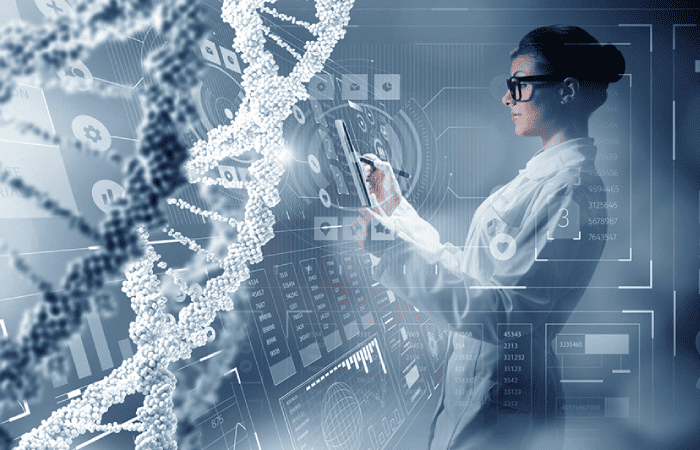Discover how CRISPR technology is being used to treat high cholesterol and uncover how this revolutionary gene-editing technique may be used in the future!
CRISPR technology has opened up exciting new possibilities in the field of medicine, and researchers are currently exploring how this gene-editing technique can be used to treat high cholesterol. Learn more about this potential breakthrough therapy, and find out how this emerging technology may be used in the future!
What is CRISPR?
CRISPR (Clustered Regularly Interspaced Short Palindromic Repeats) is a gene-editing technology that has opened up a variety of new possibilities for the medical field. This revolutionary technology involves creating precise changes to an organism's DNA, which can aid in the development of treatments for certain diseases and conditions. With CRISPR, scientists can alter existing genes or insert completely new ones into an organism’s genome, with the potential to treat anything from high cholesterol to genetic disorders.
With CRISPR, researchers have been exploring ways to reduce levels of LDL cholesterol in humans with a potentially single-shot therapy. The technology works by targeting parts of the gene responsible for producing high levels of cholesterol, allowing doctors to edit out or reduce those portions of the genetic code. Although further research is needed before any treatments can be developed and approved, experts in the field are optimistic about the potential for using CRISPR to treat high cholesterol and other genetic disorders.
CRISPR In-Depth
To use CRISPR for gene editing, scientists first create a guide RNA that matches the DNA sequence they want to target. They then use an enzyme called Cas9 to cut the DNA at the targeted location. The cell's natural DNA repair mechanisms then take over, either repairing the cut using a template provided by the scientists or deleting the targeted sequence altogether.
CRISPR has the potential to revolutionize fields such as medicine, agriculture, and biotechnology. It could be used to cure genetic diseases, modify crops for increased yield or drought resistance, and develop new treatments for a wide range of conditions. However, there are also concerns about the potential for unintended consequences and the ethical implications of editing the human germline, which could result in permanent changes to the human gene pool.
Simple Explanation
CRISPR is like a special tool that can help scientists edit genes. Genes are like a recipe book that tells your body how to work. With CRISPR, scientists can go in and change the recipe a little bit to fix problems that your body might have, like a disease or something else that isn't working right. It's like using a pencil to change a recipe in a cookbook, but for your body! Scientists are still learning how to use CRISPR, and it's a really cool tool that could help make people healthier in the future.
What is High Cholesterol?
The body needs cholesterol to function effectively since it is a fatty molecule that the liver naturally produces. High cholesterol, on the other hand, is a disease where there is too much cholesterol in the bloodstream and it builds up in the artery walls.
A key risk factor for cardiovascular disease, which can result in heart attacks, strokes, and other serious health issues, is high cholesterol. Low-density lipoprotein (LDL), frequently referred to as "bad" cholesterol, and high-density lipoprotein (HDL), frequently referred to as "good" cholesterol, are the two main forms of cholesterol. While high levels of HDL cholesterol can reduce the risk, high levels of LDL cholesterol can increase the risk of heart disease.
It's crucial to get routine check-ups and cholesterol testing to monitor your levels because high cholesterol frequently has no symptoms. Changes in lifestyle, such eating well and exercising frequently, can help lower cholesterol levels. To control high cholesterol, medication may be required in some circumstances. Develop a specialized plan for controlling your cholesterol levels and lowering your risk of heart disease with the help of your healthcare professional.
Simple Explanation
High cholesterol is a condition where there is too much of a type of fat called cholesterol in your blood. Cholesterol is important because it helps our bodies build cells and make hormones, but too much of it can be bad for us.
Imagine your blood vessels (the tubes that carry your blood around your body) are like pipes. When you have high cholesterol, it's like the pipes are getting clogged up with too much fat, kind of like how a drain gets clogged with too much hair or soap. This can make it harder for your heart to pump blood through your body, and can also make it more likely for you to get sick with things like heart disease.
Photo by Robina Weermeijer / Unsplash
How Can CRISPR Help Treat High Cholesterol?
CRISPR technology can be used to create targeted modifications to gene sequences that contribute to high cholesterol levels. Several studies have been conducted that look into how CRISPR-cas9 systems can target and modify genes associated with high levels of low-density lipoprotein (LDL) cholesterol, which is the main cause of cardiovascular disease. These modifications can potentially result in lowered cholesterol levels, allowing individuals to reduce their risk of developing heart disease.
Simple Explanation
CRISPR is a technology that scientists use to make very specific changes to DNA, which is like a set of instructions that tells our body how to work. High cholesterol is when there is too much of a type of fat in our body, which can be bad for our health.
Scientists have found that some people have a special gene that helps to lower the amount of this fat in their body. With CRISPR, scientists can try to add this special gene to the DNA of people who have high cholesterol, to help lower the amount of this fat in their body too.
It's kind of like adding a new tool to your tool kit to help you do a better job. By adding this special gene with CRISPR, scientists hope to help people with high cholesterol be healthier and avoid other health problems that can come from having too much of this fat in their body.

The Benefits of Using CRISPR to Treat Cholesterol
The benefits of using CRISPR to treat high cholesterol are numerous. Not only can it be used to rapidly and accurately target specific gene sequences associated with high cholesterol levels, but it also has the potential to reduce the risk of side effects that are commonly associated with current treatments. Additionally, using CRISPR technology could significantly lower cost due to its relative affordability and precision compared to other treatments.
Powerful gene-editing tools such as CRISPR have the potential to completely change medicine, including how high cholesterol is treated. Using CRISPR to treat cholesterol may have the following advantages:
- Targeted treatment: CRISPR can be used to target specific genes that are responsible for high cholesterol. This means that the treatment can be more precise and effective, with fewer side effects than traditional treatments.
- Permanent results: Unlike traditional cholesterol-lowering drugs, which must be taken indefinitely, CRISPR treatments could potentially provide permanent results. By editing the patient's genes, the treatment could "reset" the patient's cholesterol levels to a healthy range.
- Personalized medicine: CRISPR treatments can be customized to each patient's individual genetic profile. This could allow for more targeted and effective treatments, with fewer side effects.
- Reduced risk of heart disease: High cholesterol is a major risk factor for heart disease, the leading cause of death worldwide. By lowering cholesterol levels, CRISPR treatments could potentially reduce the risk of heart disease and other cardiovascular conditions.
- Lower healthcare costs: While the cost of CRISPR treatments is currently high, they could potentially lead to lower healthcare costs in the long term. By providing a permanent and targeted treatment for high cholesterol, CRISPR could reduce the need for expensive lifelong medications and surgeries.
The advantages of CRISPR for treating cholesterol are substantial, despite the fact that this application is still in its infancy. As this field of study develops, CRISPR might revolutionize how diseases like high cholesterol and other genetic disorders are treated.
Potential Challenges with Utilizing CRISPR Therapy
Despite the numerous benefits that CRISPR technology offers for treating high cholesterol, there are also several potential challenges. For instance, it can be difficult to precisely control where and how gene editing occurs in the body. Additionally, ethical implications may arise due to potential long-term unintended consequences of genetic manipulation. Furthermore, large clinical trials will be needed to verify safety and efficacy before it can be brought to a large scale.
However, there are several challenges associated with utilizing CRISPR therapy that need to be considered, including:
- Off-target effects: One of the biggest challenges of CRISPR is its potential to introduce unintended mutations in the genome. This can have unpredictable consequences and may even result in the development of new diseases.
- Delivery: Delivering CRISPR to the right cells in the body is a significant challenge. CRISPR requires efficient delivery systems that can transport the gene-editing tool to the desired cells without causing unwanted side effects.
- Immune response: The body's immune system may respond to CRISPR as a foreign invader, which can lead to an immune response that destroys the edited cells.
- Ethical concerns: The use of CRISPR therapy raises ethical concerns around the potential for gene editing to be used for non-therapeutic purposes, such as enhancing human traits or creating "designer babies."
- Regulatory approval: CRISPR therapy is still a relatively new technology, and regulatory agencies may require extensive testing and validation before approving the use of CRISPR-based treatments.
Notwithstanding these difficulties, CRISPR therapy has great potential benefits, and researchers are aggressively addressing the technological and moral issues that are related to it. It is conceivable that CRISPR-based medicines will be used more frequently to treat a variety of genetic illnesses as technology develops.
Looking Towards the Future: What Lies Ahead with CRISPR-Based Therapies?
As CRISPR technology continues to expand and evolve, so too will its potential for the treatment of long-term health problems like high cholesterol. Researchers are already comparing the effectiveness of various gene-editing methods, such as zinc finger nucleases and transcription activator-like effector nucleases, in hopes of finding the most efficient and effective solution. In addition, continued scientific research is focused on uncovering better ways to target exact locations in the human genome, as well as improving delivery methods for therapies into the body.
Some of the potential applications and future directions of CRISPR:
- Disease treatment: CRISPR can be used to target and modify genes that cause genetic diseases, such as sickle cell anemia, cystic fibrosis, and Huntington's disease. Researchers are also investigating the use of CRISPR to treat cancer and other complex diseases.
- Agriculture: CRISPR can be used to modify the genes of crops and livestock, potentially increasing yields, improving resistance to pests and diseases, and reducing the need for harmful pesticides and fertilizers.
- Synthetic biology: CRISPR can be used to create synthetic organisms with novel genetic traits, such as new enzymes or materials that are not found in nature.
- Biotechnology: CRISPR can be used to modify the genes of bacteria and other microorganisms to produce valuable bioproducts, such as biofuels, drugs, and bioplastics.
- Ethical considerations: As the use of CRISPR becomes more widespread, there are important ethical considerations to consider, such as the potential for unintended consequences and the need for regulation and oversight to ensure responsible use of the technology.
Ultimately, new advancements in science, legal changes, and public opinion are likely to influence the direction of CRISPR in the future. Since CRISPR has a wide range of possible applications, it is crucial to weigh those advantages against any potential hazards and moral dilemmas.
Exercise and a balanced diet can help you maintain good health.




